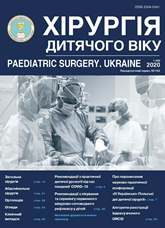Submucosal tumors of the stomach: clinic, diagnosis, treatment (literature review and own clinical observations)
DOI:
https://doi.org/10.15574/PS.2020.66.81Keywords:
submucosal tumors, gastrointestinal stromal tumors, preoperative histological diagnosis, laparoscopic resectionAbstract
Gastric submucosal tumors are a heterogeneous group of diseases that differ in etiology, clinical semiotics, and therapeutic tactics. The latter account for about 0.1-1% of all tumors of the gastrointestinal tract. In pediatric practice, the incidence is estimated at 0.02 per million, or approximately 0.4% of all gastrointestinal stromal tumors patients under the age of 20. In 70% of cases, neoplasms are diagnosed in girls. In most cases, the submucosal tumors are asymptomatic and are an accidental finding during endoscopy. Only about 3% of patients admitted to hospital and who subsequently find submucosal tumors have certain symptoms that are associated with an existing tumor. The detection of submucosal tumors has increased significantly, as evidenced by the increased frequency of scientific publications. Endoscopic examination plays a key role in diagnosis, plays a significant role in treatment and monitoring. Preoperative histological verification is extremely important from the point of view of polymorphism of submucosal tumors and the need for the correct choice of tactics for further examination and treatment. The use of laparoscopic resections of the stomach is a priority.To illustrate, examples from your own practice are given.
The research was carried out in accordance with the principles of the Helsinki Declaration. The study protocol was approved by the Local Ethics Committee of all participating institution. The informed consent of the patients was obtained for conducting the studies.
No conflict of interest was declared by the authors.
References
Galkin V, Maistrenko N. (2003). Diagnosis and surgical treatment of non-epithelial tumors of the gastrointestinal tract. Pirogov Russian Journal of Surgery. 1: 22-2.
Prokopchik NI, Grivachevskiy AS, Zhigulich SP, Andreyeva OV. (2013). Neurofibroma of the stomach. Journal of Grodno State Medical University. 2(42): 107-108.
Skoropad V. (2016). Schwannoma of the stomach. Oncology. Journal named after PA Hertsen. 1: 63-65.
Starkov Yu et al. (2010). Gastrointestinal submucous neoplasms in endoscopic practice. Pirogov Russian Journal of Surgery. 2: 52-59.
Albayrak F. (2010). Inflammatory myofibroblastic tumor of the stomach in an adult woman: a rare intermittent cause of gastric outlet obstruction. Tumori. 96(3): 492-495. https://doi.org/10.1177/030089161009600320; PMid:20845815
Cheng B et al. (2018). Primary gastric inflammatory myofibroblastic Tumor A case report. Medicine. 97: 50. https://doi.org/10.1097/MD.0000000000013423; PMid:30557996 PMCid:PMC6320093
European Sarcoma Network Working Group. (2014). Gastrointestinal stromal tumours: ESMO Clinical practice guidelines for diagnosis, treatment and follow-up.
Joensuu H, Hohenberger P, Corless C. (2013). Gastrointestinal stromal tumour. Lancet. 382: 973-983. https://doi.org/10.1016/S0140-6736(13)60106-3
Hirota S et al. (1998). Gain-of-function mutations of c-kit in human gastrointestinal stromal tumors. Science. 279: 577-580. https://doi.org/10.1126/science.279.5350.577; PMid:9438854
Jin W. (2016). Current guidelines in the management of upper gastrointestinal subepithelial tumors. Clin Endosc. 49: 235-240. https://doi.org/10.5946/ce.2015.096; PMid:26898512 PMCid:PMC4895944
Katakwar A. (2014). Primary gastric inflammatory myofibroblastic tumor in an adult – case report with brief review. Indian J Surg Oncol. 5(1): 66–70. https://doi.org/10.1007/s13193-014-0296-5; PMid:24669167 PMCid:PMC3964230
Kim GH. (2015). Сlinical and endoscopic features of metastatic tumors in the stomach. Gut and Liver. 9(5): 615-622. https://doi.org/10.5009/gnl14032
Mądro A. (2014). Neurofibroma of the stomach without Recklinghausen’s disease: a case report. Prz Gastroenterol. 9(5): 310-312. https://doi.org/10.5114/pg.2014.46168; PMid:25396008 PMCid:PMC4223121
Masoni L et al. (2014). Laparoscopic resection of large gastric GISTs: feasibility and long-term results. Surgical Endoscopy. 28: 2905-2910. https://doi.org/10.1007/s00464-014-3552-4; PMid:24879133
Miettinen M, Lasota J. (2003). Gastrointestinal stromal tumors (GISTs): definition, occurrence, pathology, differential diagnosis and molecular genetics. Pol J Pathol. 54: 3-24.
Nishida T et al. (2013). Submucosal tumors: Comprehensive guide for the diagnosis and therapy of gastrointestinal submucosal tumors. Digestive Endoscopy. 25: 479-489. https://doi.org/10.1111/den.12149; PMid:23902569
Quiroz HJ. (2018). Pediatric gastrointestinal stromal tumors – a review of diagnostic modalities. Transl Gastroenterol Hepatol. 3: 54. https://doi.org/10.21037/tgh.2018.07.08; PMid:30225388 PMCid:PMC6131159
Ries L et al. (2002). SEER cancer statistics review, 1973–1999.
Rosch T et al. (2002). Accuracy of endoscopic ultrasonography in upper gastrointestinal submucosal lesions: a prospective multicenter study. Scand J Gastroenterol. 37: 856-862. https://doi.org/10.1080/713786521; PMid:12190103
Sato T et al. (2005). Strategy of treatment of submucosal gastric tumours. Eur J Med Res. 10: 292-295.
Weigt J, Malfertheiner P. (2015). Metastatic disease in the stomach. Gastrointest Tumors. 2: 61-64. https://doi.org/10.1159/000431304; PMid:26674003 PMCid:PMC4668793
Downloads
Published
Issue
Section
License
The policy of the Journal “PAEDIATRIC SURGERY. UKRAINE” is compatible with the vast majority of funders' of open access and self-archiving policies. The journal provides immediate open access route being convinced that everyone – not only scientists - can benefit from research results, and publishes articles exclusively under open access distribution, with a Creative Commons Attribution-Noncommercial 4.0 international license(СС BY-NC).
Authors transfer the copyright to the Journal “PAEDIATRIC SURGERY.UKRAINE” when the manuscript is accepted for publication. Authors declare that this manuscript has not been published nor is under simultaneous consideration for publication elsewhere. After publication, the articles become freely available on-line to the public.
Readers have the right to use, distribute, and reproduce articles in any medium, provided the articles and the journal are properly cited.
The use of published materials for commercial purposes is strongly prohibited.

